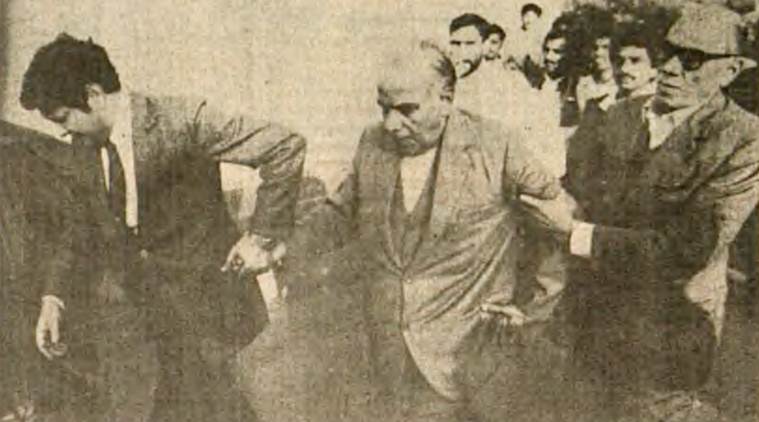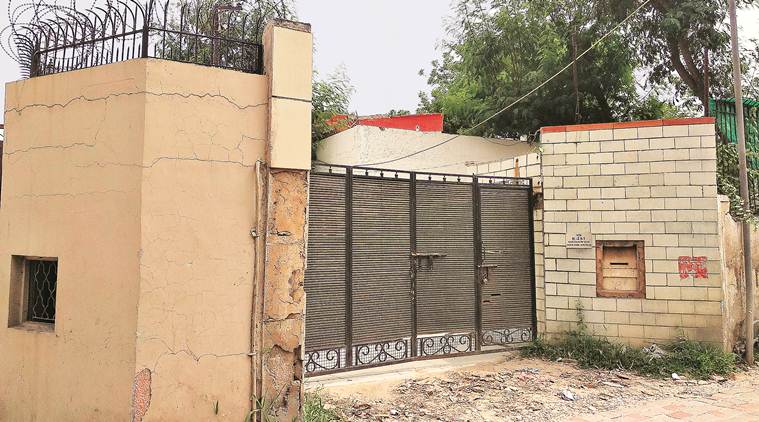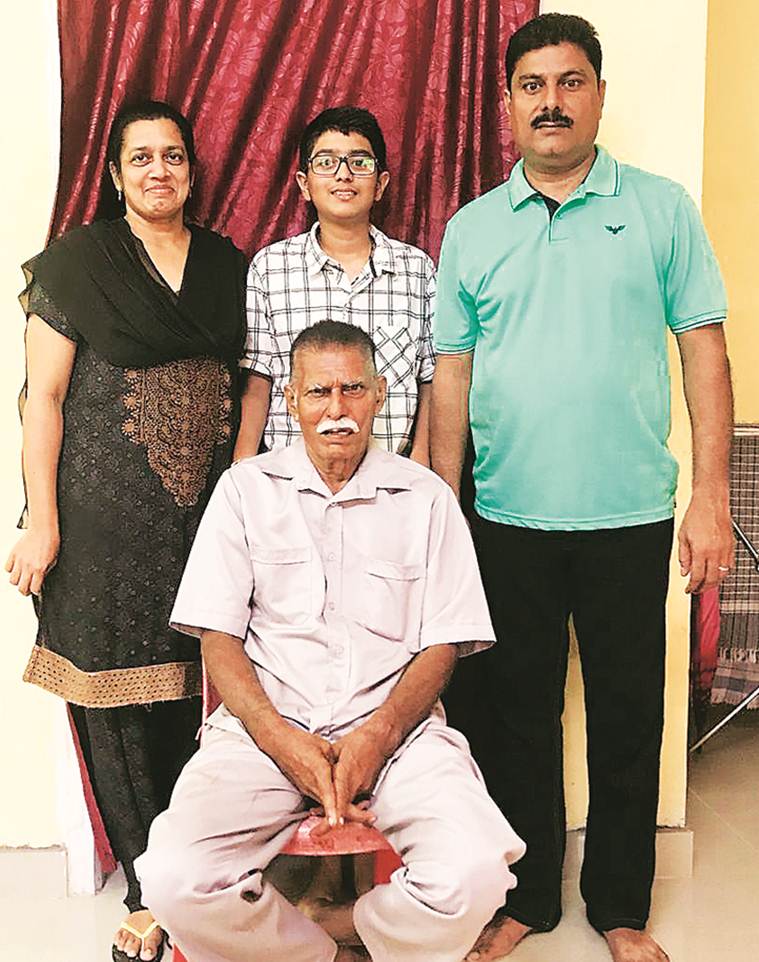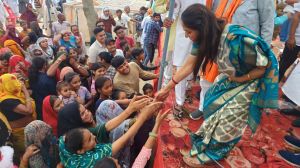- India
- International
Coomar Narain: A spy and how his stepson came out of the cold
The Indian Express on a spy and how his stepson came out of the cold.
 Coomar Narain being led away after his arrest in January 1985. (Express Archives)
Coomar Narain being led away after his arrest in January 1985. (Express Archives)
In the 1980s, the Coomar Narain spy case rocked the corridors of power in Delhi. Over a decade later, he was dead and his wife was found strangled in a farmhouse they owned. No family showed up at her funeral. Delhi Police’s search for the Narains’ legal heir led them to the door of a one-time petty thief in Mangalore
Over 18 months ago, J R Baretto, 58, a resident of Bantwal in Karnataka’s Mangalore, received a call from a relative about an odd police visit. The policemen spoke Hindi and English while the relative, Edwin D’Souza, only knew Kannada and Konkani, and he was calling Baretto to help with the translation.
A tour operator, Baretto says he instinctively thought D’Souza’s past was catching up with him. “Decades ago, Edwin uncle was a petty thief who tried stealing cars, but failed. I thought it must be about one of those old cases. But when I realised it was the Delhi Police who had visited him, I got nervous. Why would they visit from so far away?” he says. Delhi is 2,217.4 km from Bantwal, a trade town on the banks of the Nethravati river.
When Baretto didn’t make it, the policemen left, promising to come back. The next meeting between D’Souza and the police, held 12 days later, was in Baretto’s presence.
Then, as Sub Inspector Shiv Dev began speaking, ably translated by Baretto, D’Souza’s life was to change forever — the SI spoke about D’Souza’s mother Gerty Walder a.k.a. Geeta Narain; her husband Coomar Narain of the infamous 1985 spy case that had rocked the Rajiv Gandhi government, leading all the way up to the Prime Minister’s Office; and a Rs 10 crore property in South Delhi’s plush Sainik Farms that he stood to inherit.

 The farmhouse in Sainik Farms where the Narains lived. (Express photo: Tashi Tobgyal)
The farmhouse in Sainik Farms where the Narains lived. (Express photo: Tashi Tobgyal)
A property dispute
In 1995, Coomar and Geeta Narain bought E-152/A, Sainik Farms. In 2000, Coomar, 75, died, and in 2002, Geeta was allegedly strangled inside the farmhouse by an unidentified person. No relative or legal heir is known to have attended Geeta’s funeral. The farmhouse and its maintenance became the responsibility of the Ambedkar Nagar police station, since the couple had no children or known heirs.
On February 5, 2008, however, Rann Singh, a retired police officer, and Radhika, the domestic help of the Narains’, laid claim to the 950-square-yard farmhouse. “They broke open the locks and Rann Singh said the property had been rented to him by Coomar and Geeta’s ‘daughter’, Radhika. Who daughter, we wondered. To our knowledge, the two didn’t have any children,” says Dev.
To establish his claim, Singh showed a ‘rent agreement’ dated December 29, 2003.
“Even before we could probe further, Singh filed complaints with Delhi Police’s Vigilance Department, alleging that local police were trying to implicate him in Geeta’s murder,” says a policeman, who was in charge of the Sainik Farm police post in 2008, and who has since been promoted to the rank of Inspector.
Insisting the Narains were her parents, Radhika, who lives in Nihal Vihar in the Capital, says, “I was with my in-laws when my mother (Geeta) was murdered and didn’t know about her death. But some years later, when I came to settle down in my parents’ home, police threw me out forcibly. My marital family isn’t very well off and I met Rann Singh, who helped me to fight the legal battle against the Delhi Police. First, I gave him my property (in Sainik Farms) on rent and last year, I sold him the property for Rs 30 lakh since, after my husband’s death, my family’s financial condition hasn’t been too good. I had one sister, but after my (Narain) father’s arrest, she went missing.”
Days after Rann Singh’s complaint, an independent vigilance inquiry, headed by an ACP-rank officer, was ordered into his claims.
Police say that during the inquiry and cross-questioning, the duo gave “contradictory” and “misleading” statements, further arousing their suspicion that the two were trying to usurp the property. “Radhika had first claimed that she was the biological daughter of Narain. But when police told her to get a DNA test done, she claimed she was the adopted daughter. Then, she produced an affidavit signed by Narain on August 18, 1983, for her admission to Class 4 of an MCD school in Manglapuri. She was admitted to the school on August 29 but quit the school a few months later,” says the officer who was part of the vigilance inquiry.
After passing through several Investigating Officers (IO), in 2016, the property dispute case finally landed on Dev’s table, the fifth IO to handle the case. “Since the main accused in this case is a retired inspector of Delhi Police, a closure report would have been an embarrassment for the Delhi Police; we would have been accused of favouring one of our own. So we decided to examine the evidence afresh. We knew Rann Singh was trying to usurp the property. So in the absence of any legal heir of the deceased couple, we decided to trace their relatives,” says Dev.
A similar view was echoed by Additional Commissioner of Police Suvashish Choudhary. “Usually, people have the perception that police would not help them if the other party was from their department. But in this case, we tried to change this perception,” he says.
The investigation led Dev to Coomar’s birthplace, Vadakkencherry village in Kerala’s Palakkad, and Geeta’s ancestral house in Bikarnakatte, in Karnataka’s Mangalore.
What they stumbled upon was a story that spanned several decades — starting pre-Independence India, through the 1980s that saw one of the most sensational spy cases to have rocked the power corridors of Delhi and Mumbai, until it wound its way through the narrow lanes of Kodikal in Mangalore to stop at the house of Edwin D’Souza, now 76.
It’s on the basis of this investigation that police have filed a chargesheet on September 12 before a Delhi court against Rann Singh and Radhika for trespass and cheating, among other charges. Inder Singh, a municipal staffer, has been accused of helping Rann Singh and Radhika forge documents.
Coomar, Geeta, and a spy story
According to the police chargesheet, Coomar Narain was born in Vedkancharry in Kerala’s Palakkad district in 1925. When he was 18, he bagged his first job, as a havildar in the Indian Army’s Postal Service. The same year, 1943, in a Mangalore hospital, Edwin D’Souza was born to Gerty and Gilbert Walder.
“There’s some confusion if Gerty and Gilbert ever married, and whether she was an unwed mother. Anyway, the story we have been told is that Gerty left town soon after the baby (D’Souza) was born and went to Bombay, leaving her two-month-old in the care of her mother Juliana,” says Baretto.
The chargesheet says Narain was discharged from his Army job six years later and began working with the Bombay-based S L M Maneklal Industries Ltd. as regional manager. It was in this city that he met Gerty, who later married him and became Geeta. Police probe have revealed that in the 1960s, the couple moved to Delhi’s Nizamuddin area and Narain found an office space on 16, Hailey Road.
D’Souza, meanwhile, stayed on in Mangalore with his grandmother.
“Gerty used to send money home and would also visit sometimes. But for very long, Edwin uncle was made to believe his mother was Juliana, and that Gerty was his elder sister,” says Baretto.
In a chat over the phone with The Sunday Express, with Baretto stepping in to translate, D’Souza speaks of his mother Gerty Walder. “She left me when I was two months old and never returned. We didn’t have a mother-son relationship. I was raised by my grandmother Juliana and called her mother. My grandmother died 30 years ago,” he says.
With not much parental guidance, the teenager fell into “bad company”, say police.
“We found out that Gerty would come down to Mangalore sometimes. Those days, D’Souza was working as a lorry cleaner and had learnt some driving. In 1964, Gerty noticed that her son was getting into bad company and asked her mother to send him to Delhi,” says a policeman who was part of the investigation.
“We lived together in the Nizamuddin area of the city. I remember the house but I didn’t like Delhi. My life and my grandmother were in Mangalore, so I came back in six months. She looked after me well when I was there but did not stop me from leaving… That was the last time I met my mother,” D’Souza says.
During his days in Delhi, D’Souza often visited Coomar’s 16, Hailey Road office — before he took off with a car parked next door.
Police later tracked the car and D’Souza to Mangalore, where he was arrested for the theft in 1965. Over the years, D’Souza allegedly tried his hand at petty crimes in Mangalore but got caught each time.
The arrest and the subsequent cases meant that D’Souza grew distant from his family in Delhi, until he lost all contact with them.
Two decades later, in Delhi, the Narains were to find themselves in the spotlight — on January 17, 1985, Coomar Narain was arrested for allegedly “leaking classified information to foreign agents between 1977 and 1985 in Delhi and Mumbai”, according to a report in The Indian Express dated February 20, 1985. When the police raided his office on Hailey Road, Narain was allegedly found with the original copy of a classified document, and photocopies of a few others.
In 1985, the Intelligence Bureau filed an FIR under the Official Secrets Act against Narain at Delhi’s Tilak Marg police station — and thus began a series of events that rocked the Rajiv Gandhi-led Congress government.
According to the FIR filed against 19 people, including 16 bureaucrats, Maneklal Industries had allegedly passed on classified information to French, Polish and German embassies in connivance with higher-ups across ministries.
Among the bureaucrats named in the FIR were P Gopalan, private secretary in the Ministry of Defence; three private secretaries of P C Alexander, the then private secretary to former PM Rajiv Gandhi; Narain’s boss at Maneklal, Yogesh T Maneklal; director in the PMO N S Sree Raman; and senior administration officer R P Dang.
In his book titled World Famous Spy Scandals, Vikas Khatri, who wrote an entire chapter on Coomar Narain, mentions that the government presented a 2,100 page chargesheet and a list of 188 witnesses to the court. “It contained sworn affidavits of persons, who affirmed that this gang was active since 1972. Mrs Indira Gandhi had issued direction in 1982 to keep a strict watch on the Prime Minister’s and President’s secretaries. The intelligence department knew about this gang from September 1984. They started tightening noose round the necks of all these people from that time, but the matter was delayed for some time due to the assassination of Mrs Gandhi on October 31, 1984,” it says.
One of the Express reports of that period also stated that one of the accused, S Sankaran, senior assistant to then President Zail Singh’s press secretary, received Rs 7,000 for documents provided to Narain from 1982 onwards. “Sankaran reportedly revealed that the ring was in operation since 1982… he also reportedly revealed that all the accused… used to meet at the 16, Hailey Road office premises of Narain, the nerve centre of the ‘whisky for secrets’ case… Sankaran also got bottles of Indian-made foreign whisky,” the report stated.
In 2002, the spy case, one of the longest criminal trials involving the Official Secrets Act, eventually saw 12 former staff members in the PMO and Rashtrapati Bhavan Secretariat being sentenced to 10 years’ imprisonment. “They were found guilty of passing on secret official codes and classified documents pertaining to defence, shipping, transport, finance and planning, besides R&AW and Intelligence Bureau reports,” says a senior police officer.
Police say that a few years after his arrest, Coomar got out on bail, after which he purchased the farmhouse.
By then, D’Souza, after his failed attempt at crime, had made a living in Mangalore as a real-estate dealer.
“I got to know about the farmhouse only when four policemen came home about two years ago… They asked me if she was my mother; I said no. I heard of her death in 2002 from a family friend, but didn’t know she had been murdered,” he says, adding that his family once owned a “lot of ancestral property”.
Since the police visit, D’Souza’s son Prakash, 49, who had been working as a driver in Dubai for 28 years, has returned with his wife and two sons. “I’ve only seen ajji (grandmother, Geeta) once, before my marriage. We had a few pictures of hers when she was in her teens, maybe, but we have moved at least three homes since we were children and a lot of stuff was lost in transit. We did find her birth certificate and one photograph through our relatives and some other legal documents which we have handed over to the police,” says Prakash on the phone from Mangalore.
On the prospect of his father becoming the owner of a Rs 10-crore property, Prakash says, “We didn’t expect it but now we will fight for it. I will move back to India and ensure that my grandmother’s property belongs to the rightful owners — her son and his children. It will be a long legal battle but we are ready to fight.”
 Edwin D’Souza (seated) with son Prakash and his family. (Express photo)
Edwin D’Souza (seated) with son Prakash and his family. (Express photo)
The police investigation
In 2016, as Dev decided to start looking for the legal heirs to the property, he contacted the record office of the Army Postal Service Centre in Kamptee Cantonment near Nagpur, Maharashtra, where Narain used to work, hoping to get his address and service details.
The reply he received from the record office wasn’t encouraging. “They said that they had weeded out the service records of ‘No P 4287Hav/CIK CV Narayanan S/o CK Venkitarama Iyer R/o 9/209, Coimbatore district’, as they were too old,” the police said.
As Dev and his team visited R S Puram in Tamil Nadu, they hit a dead-end. The team also visited the local municipal office, post office and the police station, with little luck — the record books stopped at 1967. “I then met the priests of the local Ayyappa temples to know about Narain and his father but nobody had a clue. We then visited his hometown Vadakkencherry in Kerala. There I met one Venkatramanna, a known Iyer Brahmin — Narain was one himself — but he knew little about the family,” says Dev.
That’s when the team decided to shift their focus to Mangalore, where Geeta Narain hailed from. “We made efforts to search her antecedents on the web as ‘Geeta Walder’ since Walder is a known Christian community in Mangalore. I visited the city and its neighbouring areas, where I met the parish priests. We got to know that a woman by the name of Greta Walder had gone to Delhi in 1957. Later, we found that she had a son, Edwin D’Souza, from her previous marriage,” he says.
Police were in for a shock when they found out that D’Souza was a small-time thief and was involved in several incidents of theft. But they still needed documentary proof that Geeta was D’Souza’s mother.
“We then sent a letter to the Station House Officer of Mangalore police station, asking him to provide certified copies of Edwin’s criminal dossier. We were in for some luck — in those papers, he is mentioned as the son of B G (Gerty) Walder alias Geeta Narain, wife of C V Narain, resident of C-33A Nizamuddin. We also found the noting of the Circle Inspector of Mangalore town, dated July 1, 1969, where he had stated that Edwin was the son of B G Walder, daughter of Juliana D’Souza,” he says.
“All these facts establish that Edwin is the son of B G Walder alias Geeta Narain and the only legal heir of the property,” Dev concludes.
As it happened
1925: Coomar Narain was born in Vadakkencherry in Kerala
1943: He joined the Indian Army Postal Service but was discharged from duty six years later
1949: He joined the Ministry of External Affairs as a stenographer and visited several countries
1960: Narain began working for Bombay-based S L M Maneklal Industries as its regional manager. He started gathering classified information from the offices of the Indian President and PM
1985: He was arrested for allegedly leaking classified information to foreign agents between 1977 and 1985 in Delhi and Mumbai. A few years later, he came out on bail and purchased a property in South Delhi’s plush Sainik Farms area
2002: 12 former staff in PMO and Rashtrapati Bhavan Secretariat were sentenced to 10 years imprisonment after they were found guilty of entering into a criminal conspiracy with officials of foreign embassies
Apr 25: Latest News
- 01
- 02
- 03
- 04
- 05









































